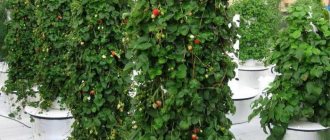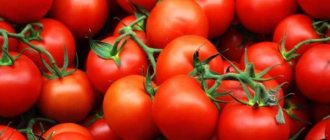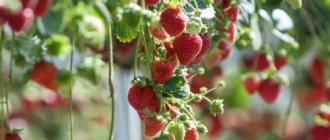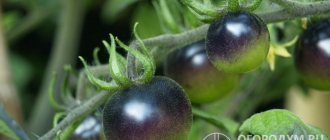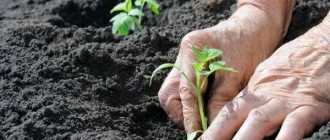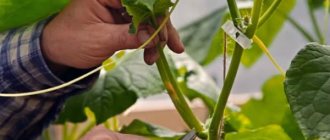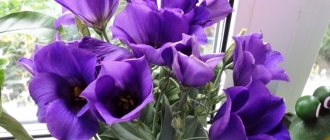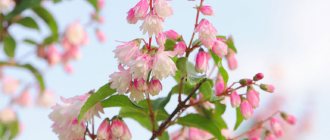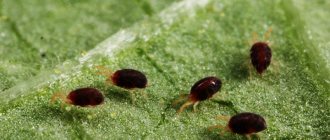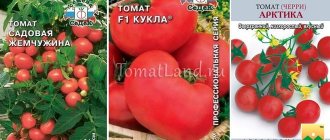Today, the cucumber seed market is flooded with parthenocarpic hybrids that have only female flowers and do not require pollination to produce fruit. But many summer residents still remain faithful to traditions and grow bee-pollinated cucumbers, while novice gardeners do not quite understand the meaning of such an action. But parthenocarpic and bee-pollinated varieties and hybrids can completely complement each other (for example, the former are more suitable for greenhouses, the latter – for open ground).
Next, we’ll talk in more detail about what bee-pollinated cucumbers are, why they are worth growing, how to do it correctly, what are the nuances and features of care. In addition, your attention will be provided with a list of the most popular and best bee-pollinated varieties and hybrids of cucumbers intended for cultivation in open ground (primarily) and in a greenhouse.
Bee-pollinated cucumbers: advantages and disadvantages of the crop
Insect-pollinated cucumbers are nothing new. Such plants have been grown in our temperate continental climate for many years. Recently, new varieties have been developed that make it possible to harvest vegetables at the earliest possible date. Typically, early ripening cucumbers begin to bear fruit after 40-45 days. The fruits have a delicate peel, white thorns, juicy pulp, size - 10-12 centimeters.
Many early cucumbers are salad cucumbers; their length differs from ordinary ones - they are slightly oblong (about 27 centimeters).
True, some early varieties have thicker skin, dark thorns, they can be eaten fresh and used for pickling.
Medium or late varieties of cucumbers come in different lengths. Tiny gherkins grow up to 5-9 centimeters. Hybrid varieties are distinguished by a bunched ovary, the length of the fruit is 9-12 centimeters. Such crops give a large harvest. However, cucumbers with similar qualities cannot be grown from the seeds of their fruits. Vegetables ripen only after 50-60 days. Basically, all late crops are grown for preservation or pickling.
Pros of insect-pollinated varieties:
- excellent taste characteristics;
- disease resistance;
- cold resistance;
- good yield under favorable weather conditions;
- seed can be obtained.
Minuses:
- dependence on the presence of insects;
- in the sun, with little watering, cucumbers become bitter;
- Yields may be reduced due to unfavorable weather conditions.
It is recommended to plant early, mid and late varieties in the garden. In this case, it will be possible to harvest throughout the season. Gardeners need to know that there are two types of cucumbers. Some grow on low bushes that you don’t have to deal with. Others form tall stems that need constant care. First, remove the side stepsons, form a stem, and at the end, pinch the top.
Crops with long stems need support; they are usually allowed to climb along a trellis. Bee-pollinated cucumbers are usually planted in an open bed. Although it can be planted in a film greenhouse or greenhouse. It is advisable that the plant be completely open to insects at the time of flowering.
Reviews
Rita, Babaevo
I don’t change my favorite bee-pollinated cucumber varieties. Every year I have Parisian gherkins, Libelle, and cucumbers growing in my garden beds. I cover it all summer with lutrasil, if it’s hot, they open it, and the bees fly. Cucumbers set quickly, just have time to pick them. Only these are suitable for pickling (salt in tubs), the hybrids do not have the same taste. Hybrids go into jars, for marinades, and for pickling, there are no better bee-pollinated and aromatic ones.
Oleg, Suzdal
Growing cucumbers in the garden in our region is not so difficult, but making them tasty and crispy is more difficult. About four years ago we planted only self-pollinating hybrids, and although the harvest was good, I didn’t like the taste. So we returned to the proven old varieties - Nezhinsky, Phoenix. They bear fruit abundantly; when fertilized and watered, the shoots bend from the cucumbers. They grow well in beds, without shelter. For an early harvest, I sow a couple of hybrids in greenhouses.
Bee-pollinated cucumbers are distinguished not only by their resistance to diseases and pests, but also by their excellent taste and high yield. Fans of winter preparations are advised to pay attention to these varieties, which are best suited for salting and pickling.
Which cucumbers are better: bee-pollinated or self-pollinated?
It happens that due to rainy, cool weather or a small number of insects, all cucumber flowers are not pollinated, that is, pollen from male flowers does not fall on female ones. The ovaries are not fully formed, which reduces the yield. However, breeders have come up with new hybrid crops—parthenocarpic cucumbers.
Only female flowers grow on plants, and ovaries are formed without pollination. Typically, such crops are planted in greenhouses.
There is another type of cucumber - self-pollinating. They have pistils and stamens in one flower, that is, the process of pollination occurs when pollen from the stamens enters the pistil. The plant pollinates itself, without involving any insects in this process. Subsequently, fruits with seeds inside are formed. Self-pollinating crops are usually grown in film greenhouses, on balconies and even on window sills.
If we compare the taste qualities of different types of cucumbers, then those that are pollinated by insects are better. They are crispy, juicy, not bitter, with a pleasant cucumber aroma. However, self-pollinating varieties have higher yields. After all, ovaries are formed regardless of the presence of insects or weather conditions.
Why do cucumbers have only one empty flower?
F1 Arina
Natalya Levitskaya
F1 Acorn
There is a large group of shade-tolerant cucumber hybrids cultivated in heated greenhouses from January to July or until the end of October (F1 Marathon, F1 Relay, F1 Manul, F1 TSHA 442, F1 Ladoga, F1 Northern Lights, F1 Olympics, etc.).
Last year, cucumbers were planted in a box on the balcony. The tops were gorgeous, the flowering was constant. But not just one ovary after flowering.
- Try to pinch the top (it is better to do this above the 5-6th leaf, but if you have already missed it, then pinch it as is) - this will stimulate the growth of side shoots, and there are always more female flowers on them.
- Self-pollinating varieties for greenhouses.
Frederica
Powdery mildew of cucumbers
weak
understand the growth of lateral shoots from almost every node of the main stem; side shoots are long and require pinching in greenhouses. Many modern hybrids with good branching are characterized by a valuable trait - SELF-REGULATION OF BRANCHING, when a high crop load on the main stem does not allow side shoots to quickly form (F1 Maryina Roshcha, F1 Chistye Prudy, F1 Matryoshka, F1 Junior Lieutenant, F1 Buyan, F1 Burevestnik, F1 Boy with a finger, F1 Hit of the season, F1 Green Wave, F1 Dragonfly, etc.). Later, when most of the harvest has been harvested from the main stem, the side shoots will begin to grow faster. Thus, in the presence of self-regulation of branching, much less time is spent on pinching side shoots
This is especially important if your stay in the garden area is limited to weekends - such plants do not have time to overgrow too much during the working week.
F1 Lord
F1 Company secret
F1 Teremok
F1 Northern Lights
They pollinated with a brush and blew on the flower, all in vain.
ARTMAX
Parthenocarpic cucumber is a variety or hybrid that is capable of producing fruits WITHOUT pollination. ...Why are these parthenocarpic cucumbers needed in principle? In principle, it’s clear why - for...
Spaanch Boob
What cucumbers do gardeners most often look for when buying seeds? Probably, a friendly chorus will answer - self-pollinating! What kind of cucumbers are these? Let's try to figure out today what it is and why we need it?
How to protect cucumbers from late spring cold?
Yulia Muromskaya
branching includes early ripening sprinter hybrids that give away most of the harvest in the 1st month of fruiting: F1 Alphabet, F1 Cupid, F1 Regina-plus, F1 Bouquet, F1 Balalaika, etc. There are practically no side shoots - i.e. They are very short (up to 10-15 cm) “bouquet branches” - with close internodes, often without leaves, which stop growing on their own. Such bouquet branches with filling greens look like bunches of fruits.
F1 Junior Lieutenant
F1 First class
Some bunched gherkins are also shade-tolerant (F1 Maryina Roshcha, F1 Chistye Prudy, F1 Hit of the Season, F1 Green Wave).
But for high-quality pollination, they need to be sown with varieties that produce a large number of male flowers (barren flowers). Breeding companies put colored pollinator seeds in bags of the main bee-pollinated hybrids. These bags have a special symbol - a yellow seed in a pink square and the text “colored seeds are a pollinator.”
F1 Relay
Apparently this is some kind of special variety.
dolfanika
And also read the information about your variety - on some varieties, flowering begins with male flowers, and female flowers will appear later.
Growing and care in a greenhouse
Insect-pollinated crops can be grown in a greenhouse, but it will be difficult to lure bees there. It is advisable to open windows and doors wider at the time of flowering or completely remove the film covering.
When to sow and plant seedlings
From the moment of sowing the seeds to transferring the seedlings to the garden bed, 20-25 days should pass. Then the plant will develop for another 20 or 30 days. If you sow the seeds in early May, then by the end of this month you can plant the seedlings in the greenhouse, and in June you can harvest the crop.
It is not advisable to sow fresh seeds. The seed must sit for at least two years. Before sowing, the seeds are heated or hardened at low temperatures, then, for disinfection, they are soaked for 20 minutes in a pink solution of potassium permanganate.
The growing seedlings are initially kept in a heated room, and at the stage of 4 true leaves they are transferred to the greenhouse.
Cucumbers do not like picking or root breaks. It is advisable to immediately plant the seedlings in peat cups.
See also
Why are there a lot of barren flowers on cucumbers and what to do?
Read
Seating Charts
The seedlings are transplanted into pre-dug holes. Planting scheme: cucumbers are planted in rows, each row can have two furrows. The crops are planted opposite each other, at a distance of 50 centimeters. There should be at least 40 centimeters to the neighboring bush. It is advisable to leave a gap of 80 centimeters between the rows.
What crops can be planted with cucumbers?
It is advisable to grow each crop separately. However, in the neighboring bed you can plant Chinese cabbage, turnips, mustard, peppers, and eggplants. The best option is dill. This plant, thanks to its aroma, will repel pests from cucumbers. Along with cucumbers, you can plant green beans. It doesn't take up too much space. Cucumbers and beans need the same amount of watering. It is not recommended to plant tomatoes and potatoes near cucumbers.
Is it possible to plant self-pollinating and bee-pollinated crops together?
Several types of cucumbers can be planted in one greenhouse, but preferably at a distance of 80 centimeters from each other. Crops of the same variety can be planted in adjacent beds, in the same row. Self-pollinating plants will produce crops regardless of the presence of insects. Crops pollinated by bees will form ovaries if their flowers are pollinated by bees, flies, and bumblebees.
Frequency of watering and fertilization
Immediately after transplantation, the seedlings are watered regularly (every 2 days). Water consumption is 2-3 liters per 1 square meter. At the moment of ovary formation and fruiting, the amount of moisture is almost doubled. Watering is carried out in the evening. If it is too hot during the day, then after 16 hours the bushes can be irrigated with water. During intense heat, this procedure is not recommended - the leaves can quickly burn in the sun.
Water for irrigation is taken warm, not hard, and settled. It is advisable to collect rainwater in barrels or canisters and water the cucumbers with it.
During the development period, cucumbers need additional feeding. Organics and minerals are added to the soil even before seedlings are planted. Two weeks after transplanting the seedlings, they are fed with mullein or nitrogen fertilizers. Take a liter of mullein solution or 30 grams of nitroammophoska per bucket of water.
During the flowering period, the following feeding is done: for 10 liters of liquid, take 30 grams of potassium sulfate, superphosphate, and urea. During fruiting, the bushes are fed as follows: take 0.5 liters of mullein or 30 grams of nitroammophosphate and potassium sulfate per bucket of water.
Forming cucumbers
For bee-pollinated varieties, a frequent problem is the formation of empty flowers, when only male flowers appear on the bush. In this case, the main stem is pinched. This procedure stimulates the development of side shoots on which ovaries are formed. The crop will bear fruit better if stepsoning is carried out. Remove the side shoots formed at the nodes of the lashes, while leaving the ovaries that appear
How to pollinate in greenhouse conditions
In closed structures, problems with pollination of flowers often arise. Even through windows and doors that are wide open, insects are reluctant to fly. You can help crops and pollinate flowers using a soft paint brush.
Male and female flowers grow on the same stem. The female ones have a small ovary under the flower. Using a brush, pollen is collected from male flowers and transferred to female flowers. You can pick a male flower, tear off the leaves and use the stamen to pollinate the pistils of female flowers.
Landing nuances
Sunny areas with loose, fertile soil are allocated for bee-pollinated cucumbers. They prepare the soil in the fall: dig with one and a half shovels, at the same time laying compost at the rate of 6 kg/m². If the acidity is high, add lime or dolomite flour. In the spring, the area is harrowed to cover the moisture. In unheated greenhouses, warm beds are prepared in the fall, using manure as “biofuel.”
Forcing seedlings
In warm areas, seeds are sown directly into the ground. In harsher climates, cucumbers are grown in seedlings. Sowing is carried out at the end of April, so that by the time of planting in the beds the seedlings have reached the age of 25 days and have 3 true leaves.
If the seeds are collected independently, they are disinfected in a solution of potassium permanganate for about 20 minutes, and then sown in peat pots with fertile soil. Planting depth – 1 cm.
The containers are placed under glass on a bright windowsill; after the sprouts appear, the protection is removed, and the seedlings are provided with additional lighting in the morning and evening hours to ensure the required length of daylight.
Schemes and timing of planting seedlings
Seedlings of bee-pollinated cucumbers can be planted in beds only after stable warm weather has established, when the soil at a depth of 10 cm warms up to 12-15 °C. When the optimal time comes, holes are prepared on the site according to a 30 x 50 cm pattern. When growing vertically, furrows are made with a row spacing of 80-100 cm, where a trellis is installed. If the saplings are planted when there is a risk of night frosts, a film is pulled on top.
What crops are planted with cucumbers?
To maintain crop rotation, it is better to grow each vegetable separately. However, in a small area, as well as in closed ground, you can place Chinese cabbage, turnips, mustard, peppers, and eggplants next to the cucumbers. Green beans are suitable as a neighbor. It does not take up a lot of space and needs a similar amount of moisture as cucumbers. To prevent pests, dill plants are planted between plantings.
For your information!
You should not place tomato and potato bushes near cucumbers.
Joint planting of parthenocarpic and bee-pollinated varieties
Self-pollinating representatives of the crop will produce a harvest in any case. But varieties that need insects are placed taking into account the type of flowering. You can plant cucumbers with female flowers on one row, and with male flowers across the row. Although the recommendation is similar for varieties with mixed types of inflorescences. Dividing varieties into groups makes it easier to care for and harvest, especially since ripening times may differ.
Planting and caring for plants in open ground
Cucumber seedlings are planted in the garden at the end of May. If the air has warmed up to 15-18 degrees Celsius, there is no danger of night frosts, and the soil temperature is 10 degrees, then young plants can be transferred as early as mid-May. The seedlings are first hardened, that is, gradually accustomed to the new environment. At the end of May or at the beginning of June, you can immediately sow the seeds in the garden. True, the crop will begin to bear fruit only in July. But the bushes will grow more viable.
Before planting cucumbers, the soil needs to be prepared: dug, fertilized, loosened. A bucket of rotted humus and 30 grams of nitrogen, potassium and phosphorus fertilizers are added per 1 square meter of plot. Cucumbers prefer non-acidic soil. It is advisable to add another 500 grams of wood ash or dolomite flour. Before planting, the holes can be disinfected with a pink solution of potassium permanganate.
When choosing a place for cucumbers, it is advisable to take into account some nuances: bushes in direct sunlight quickly wither. Vegetables can be planted in partial shade or near tall crops (sunflowers, green beans). You cannot plant cucumbers in a bed where tomatoes and potatoes used to grow. Predecessors can be onions, carrots, radishes.
Cucumbers planted in the garden are watered regularly. For irrigation, use settled, warm water. About 4 liters of water are poured under each bush at a time. True, you can’t pour water under the root. Water the plants every 2 days, more often in hot weather, and stop watering in cool, rainy weather. When the plants bloom and begin to form ovaries, the water consumption is doubled. At the time of fruiting, the bushes also need more moisture.
See also
How to make a net for cucumbers with your own hands and installation rules
Read
2 weeks after planting, the plants are fertilized with organic matter or nitrogen fertilizers. At the time of flowering, potassium and phosphorus supplements are added. When fruiting begins, the bushes are fed with nitrogen and potassium substances. Usually, for 10 liters of water, take 30 grams of any fertilizer or 1 liter of mullein.
Bushes need to be constantly looked after. Loosen the soil and remove weeds. Tall stems are tied to a support. You constantly need to ensure that the bushes are not too dense and to shape them. The side shoots are removed, leaving only the ovaries; the top, after the formation of the 11th leaf, is pinched.
To combat diseases, biological preparations or fungicides are used. For prevention, plants are irrigated with a solution of Bordeaux mixture. If cucumbers do not form ovaries well, spray with a solution of boric acid.
Preventive spraying with a solution of potassium permanganate or copper sulfate helps against all diseases. To control pests, infusions of tobacco, wood ash, onions, garlic, and a solution of laundry soap are used.
See also:
Who planted these cucumbers
? I planted them last year. But I was unlucky. The seedlings were eaten by ants. Who planted the cucumbers in this series? As a result? A bag of seeds (6 pieces) costs 90 rubles. Should I take it or not?
| How and where you can use brine from canned tomatoes and cucumbers. Brine from tomatoes and cucumbers is always useful. Previously, I somehow didn’t pay attention to him: we ate tomatoes and cucumbers, but the brine was usually thrown away. But with age, and maybe with experience, since in our family the motto and life principle “Everything will do on the farm, everything will come in handy” has found application for brine. Well, it’s a shame to waste such yummy food! Gradually I figured out where I could use it... Read more" |
| Let's create a royal garden together Often, gardeners want their garden to be different from their neighbor's and have its own individuality. In the movies we always admire beautiful garden pictures. But many don’t realize that you can create a royal garden on your own property and thereby surprise your friends and neighbors. |
| We waited together for warmth... Let me introduce myself - Valeria. I hope we can be friends. I'm not much of a gardener. We bought a house just last year. I like it here. So many useful things, and most importantly a lot of positive things! For a number of reasons, I am now at home, idle, waiting for the sowing season. I have 2 friends sitting with me. Above in the photo they are bored. And I missed you too, I hope it was fruitful. I present to your judgment my “boredoms” |
How to attract bees to pollinate cucumbers in an open area?
During the flowering period of cucumbers, it is not advisable to light a fire or burn anything in the area. Bees and many other insects cannot tolerate smoke, and it can cause them to fly away from an area forever. During flowering, the bushes are sprayed with a sugar solution (100 grams per 1 liter of water). This technique attracts wasps, bees, and bumblebees. Insects willingly fly into the garden bed where dill, fennel, cilantro, watercress, and mint grow. In the middle of the garden you can plant flowers that bees love: petunia, sunflowers, cornflowers, clover, marigolds.
Why do you need to form cucumber bushes?
The volume of green mass produced by cucumber bushes is largely a varietal feature. The cucumber plant forms the main shoot, which can reach a length of 5 meters, from which the side shoots of the first row grow. The number and length of lateral branches also largely depends on the variety. Most cultivated varieties grow quickly and require plant formation.
Formation is the restriction of the growth of the main stem or lateral shoots for better growth and development of those vines that should grow further and form a crop. This treatment aims to reduce the mass of the vegetative aerial parts to such an extent that proper growth and formation of fruit buds left on the plants is obtained. Growth is limited by pinching, when the growth points of stepsons or lashes are removed.
Proper formation of cucumber bushes provides a number of advantages:
- productivity increases;
- saving area of a summer cottage;
- the likelihood of plant infection with fungal and bacterial diseases is reduced;
- The collection of greens is greatly facilitated.
The best bee-pollinated hybrids
In recent years, new bee-pollinated varieties and hybrids of cucumbers for open ground have been developed. They form ovaries better, get sick less, and are more attractive to insects.
Fontana F1
A hybrid crop that begins to bear fruit after 50 days. Cucumbers grow up to 12 centimeters in length, with a diameter of up to 5 centimeters. The weight of one vegetable is 105 grams. It is possible to collect up to 9 kilograms of crop from the bush.
Guys from the F1 garden
Culture with female flowering type. The ideal shape of ripe fruits allows them to be used for preservation. The length of the vegetable is 10 centimeters, weight is 100 grams. The crop tolerates drought well and rarely gets sick.
Libelle F1
A long-climbing hybrid that matures in 50 days. The length of the cucumbers is 12 centimeters, weight – 110 grams. The pulp is juicy, without bitterness. From one bush you can harvest up to 10 kilograms of crop.
Lord F1
Mid-season crop. Lord F1 has fruits 12 centimeters long and weighing 110 grams. The plant bears fruit well even in unfavorable weather conditions and rarely gets sick.
Kumanek F1
Fruits well in dry regions. The culture forms a low bush that needs a stepson. The length of mature fruits is up to 15 centimeters, weight - 115 grams. The fruits have no bitterness.
Brownie F1
Late variety. The plant is strongly climbing. The length of the fruit is 6-9 centimeters. Vegetables are not bitter and are ideal for preservation.
Kids on the F1 branch
Early hybrid. Begins to bear fruit after 42 days. The cucumber is 8 centimeters long and weighs 75 grams. Vegetables do not have voids inside.
Hector F1
Description: early crop that begins to bear fruit after 32 days. The length of the greens is 12 centimeters, weight is 100 grams.
True friends F1
The peculiarity of this variety is that the crop begins to bear fruit already on the 37th day. The length of mature vegetables is 8-9 centimeters, weight is 90 grams.
No hassle F1
Characteristics of the variety: early, ripens in 40 days, suitable for preservation. The length of a mature vegetable is 9 centimeters, weight is 95 centimeters.
Jagged
The crop begins to bear fruit only on the 50th day. The fruit has a length of 10.5 centimeters and a weight of 90 grams.
Moscow delicacy
The culture bears fruit on the 42nd day. The Moscow delicacy has medium-length greens that do not outgrow and are excellent for canning.
Twixie
This crop can be harvested on the 37th day. Twixie fruits are small (8 centimeters). Weight - 85 grams. From one bush you can harvest up to 6 kilograms of crop.
Hope
Early culture. Nadezhda has greens measuring 10 centimeters and 100 grams long. One bush can produce 8 kilograms of harvest.
Rita
The first harvest can be harvested after 48 days. Rita has gherkin-type greens, 6 centimeters long, weighing 70 grams.
Nugget
The culture bears fruit on the 45th day. The nugget has a long stem (up to 1.8 meters). The size of the vegetables is 10 centimeters, weight is 95 grams.
Moringa
The harvest of this crop can be obtained on the 48th day. Moringa has no bitterness. The length of mature fruits is 6-8 centimeters. This is a gherkin crop.
Erofey
Mid-season crop with medium-sized fruits. Erofei has a long stem that needs shaping. The fruits are eaten fresh and used for preservation.
Humidity
Maintain the optimal temperature for the cucumber crop in the greenhouse (see table 1. Heating the greenhouse). During prolonged hot weather, the glazed surface of the greenhouse is sprayed (but not covered) with chalk solution. The relative air humidity in the greenhouse should be at least 85-90%. With such humidity, plants develop better and the reproduction of spider mites is delayed.
They increase air humidity with “poultices”, watering all passages, under-shelf spaces and heating devices with water at 12-13 o’clock in the afternoon in sunny weather. The windows are closed for 1 hour.
Air humidity is determined using an August psychrometer. You can do it yourself as follows. Two alcohol or mercury thermometers are attached to one board (with a shelf below) and hung in the greenhouse at plant level. The end of one thermometer is wrapped in one layer of white thin fabric (preferably cambric) and secured with thread. The lower edge of the fabric is lowered into a small glass or jar placed on a shelf. A small amount of snow, rain or boiled (chilled) water is poured into a glass. This will cause the fabric to become damp.
8-10 minutes after installation in the greenhouse, temperature readings are simultaneously recorded on both thermometers. On dry conditions it will always be higher. For example, dry 20°C; on wetted 17. Therefore, the difference in temperature is 3°C. Using the psychrometric table (Table 1), we establish the relative air humidity in the greenhouse.
To do this, we find the number at the intersection of the line from number 17 horizontally (temperature of the wet bulb), with a number of numbers from number 3 vertically (difference between the temperatures of the wet and dry thermometer), mentally lowering the perpendicular to the intersection with the first line. The number of the intersection of these two indicators will be the value of the relative air humidity in the greenhouse. In this case - 73%.
1. Psychrometric table of relative air humidity readings, %
| Wet thermometer readings, °C | Difference between dry and wet thermometer readings, °C | |||||||
| 0,5 | 1 | 2 | 3 | 4 | 5 | 6 | 7 | |
| 90 | 81 | 64 | 50 | 36 | 26 | 16 | 7 | |
| 1 | 90 | 82 | 66 | 52 | 39 | 29 | 19 | 11 |
| 3 | 90 | 82 | 69 | 56 | 44 | 34 | 26 | 17 |
| 5 | 91 | 85 | 71 | 59 | 48 | 39 | 30 | 23 |
| 7 | 92 | 86 | 73 | 62 | 52 | 43 | 35 | 28 |
| 9 | 92 | 86 | 75 | 65 | 55 | 47 | 39 | 32 |
| 11 | 94 | 88 | 77 | 67 | 58 | 50 | 43 | 36 |
| 13 | 94 | 88 | 78 | 69 | 61 | 53 | 46 | 40 |
| 15 | 94 | 89 | 80 | 71 | 63 | 55 | 49 | 43 |
| 17 | 95 | 90 | 81 | 73 | 65 | 58 | 52 | 46 |
| 20 | 95 | 91 | 82 | 75 | 67 | 61 | 55 | 49 |
| 24 | 96 | 92 | 84 | 77 | 70 | 64 | 59 | 53 |
| 26 | 96 | 92 | 85 | 78 | 71 | 65 | 60 | 55 |
| 28 | 96 | 92 | 85 | 79 | 72 | 67 | 62 | 57 |
| 30 | 96 | 93 | 86 | 79 | 73 | 68 | 63 | 58 |
Formation methods
There are a lot of methods and associated formation schemes, and new ones are constantly being developed. Let's look at the most popular techniques.
- With garter . Many methods of forming a bush require tying, especially at the initial stage of growth. When attached to a wire, the garter acts as a support throughout the growing season. The garter protects the plant from breaking the stem.
- No garter. For cucumbers with short vines, the garter makes no sense. The plant is able to independently maintain a vertical position.
- On the trellis. It can be wooden and originally designed. You can plant a row of cucumbers, stepping back 25 cm from the mesh or fence, and stretch oblique strings from them to the top of the fence. Over time, the vines will cover the entire fence.
- On a wire. At the ends of the bed, where cucumbers are planted in 2 rows, 2 one and a half meter pillars are buried, 2 rows of wire are pulled between them. A twine is tied to each plant in the first row, thrown over 2 rows of wires and tied to the plants of the adjacent row. The result is a green hut.
- On the grid. The method is very popular among vegetable growers. At the ends of the cucumber ridge, one pipe is buried, and a mesh is pulled over them. Lower shoots and leaves should be removed to improve natural ventilation. As the vines grow, they will attach themselves to the mesh.
- Growing in spread. Cucumbers in open ground must branch. To do this, pinch the main stem. There is no need to do anything else, the cucumbers will grow without formation, forming fruits on the main stem and lateral shoots.
Photo. Options for managing bushes
